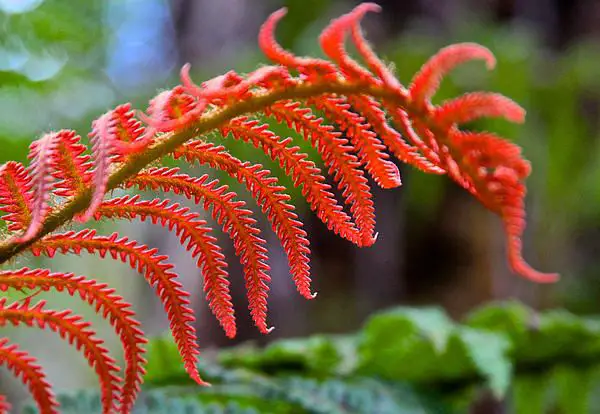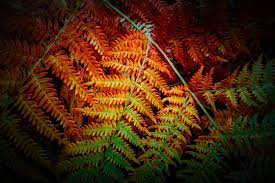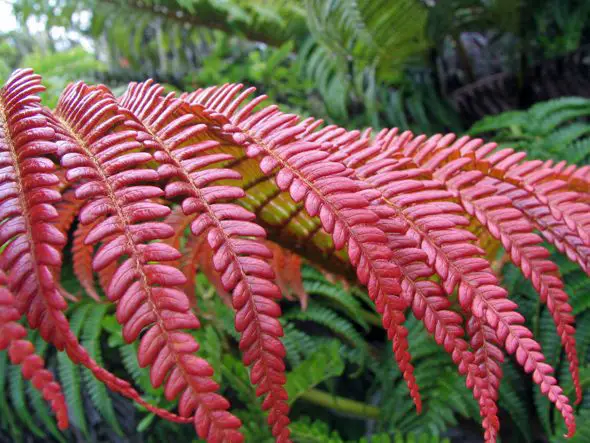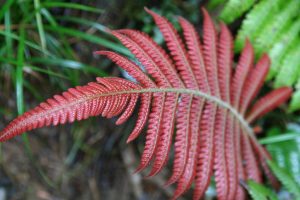Helpful Guides on each Category

Red Fern plants (Selaginella erythropus), known for their vibrant foliage and easy maintenance, offer a delightful addition to any garden or interior space.
These charming ferns hold a unique allure, enhancing the beauty of both outdoor landscapes and indoor décor. Although they are not the most common types of fern plants, having them grow on your balcony or window garden makes you feel like the owner of a rare gem.
This guide aims to assist you in achieving thriving Red Ferns, making the process of growing and caring for them stress-free.
Overview of Red Fern Plant
| Genus | Selaginella |
| Max Size | Up to 80 ft. |
| Growth rate | Slow |
| Light | Indirect |
| Soil Type | Loamy, Well-Draining |
| Soil pH | 6.0 to 7.0 |
| Watering | Moderate |
| Temperature | 60°F to 75°F (15°C to 24°C) |
| Toxicity | Mildly Toxic |
| Hardiness Zones | USDA 5-9 |
| Pests | Aphids, Mealy Bugs |
| Diseases | Leaf spot |
Botanical Description of Red Fern Plants

Red Ferns belong to the genus Selaginella of plants that engulf ferns. Their distinctive feature lies in their striking red fronds, which set them apart from other ferns. These ferns grow in a cluster, forming a unique visual spectacle.
Red Ferns thrive in lush, damp environments. They are commonly found in the understory of dense forests, where they benefit from the filtered sunlight that permeates through the canopy. These ferns are native to regions with high humidity, such as the Pacific Northwest and parts of Asia, where the moisture in the air provides the ideal conditions for their growth.
Red Fern Plants Care

Light
Red fern Plants thrive in partial shade better. For the well-being and lasting vitality of your Red Fern Plants, select a well-lit spot where your fern can receive a minimum of 6 hours of indirect sunlight each day.
Exposure to light plays a pivotal role in enhancing the enchanting red hue of the fronds, which may lose their vibrancy in the shade. Ideally, it’s best to position the fern in the gentle morning sun for 2-3 hours daily to optimize its growth and colouration.
Watering
it’s crucial to strike the right balance. Overwatering can lead to root rot, while underwatering can cause stress.
Soil
For best growth, Red Ferns require a well-draining, nutrient-rich soil that retains moisture effectively.
An ideal soil mixture for ferns can be achieved by blending equal proportions of potting soil, compost, and either perlite or coarse sand. Incorporating a small amount of peat moss or sphagnum moss into the mixture will aid in maintaining soil moisture levels and creating a slightly acidic environment.
Temperature and humidity
These play vital roles in the Red Fern plant care. The plant thrives in temperatures ranging from 60 – 75 °F, which is approximately 15 – 24 °C. While it can endure slightly cooler conditions, try to shield the plant from frost and chilly drafts to ensure its well-being.
Red Fern Plants like very humid environments, ideally around 50 per cent or higher. If the indoor air in your is always dry, you can improve the humidity for the plant by situating it on a tray filled with pebbles and water.
Fertilizing
Using a balanced, slow-release fertilizer during the growing season can promote healthy foliage and vibrant colouration.
During the growing season, I’ll advise you to fertilize Red Fern Plants once a month. However, as fall and winter approach, reduce the frequency of fertilization.
To prevent any harm to the plant’s delicate roots, what I do is dilute the fertilizer to half its recommended strength.
Keep in mind that excessive fertilization of outdoor ferns leads to the browning of the outer fronds or frond tips.
Pruning and trimming
Regularly removing dead or damaged fronds not only enhances their appearance but also encourages new growth. Trimming will help control the fern’s size and shape, keeping it attractive in your garden.
Propagating Red Fern Plants

Red Ferns thrive when planted at the right time and in suitable conditions. The ideal planting time for Red Ferns is typically in the spring or early fall when the weather is mild. Red fern plants thrive best in USDA hardiness zones 5 to 9.
To prepare the planting area or pot for Red Ferns, start by selecting a location that provides the required lighting conditions.
For outdoor planting, choose a partially shaded spot that receives at least 6 hours of indirect light with well-drained soil. If you’re planting in a pot, select one with good drainage and use a high-quality potting mix suitable for ferns.
Because ferns have shallow roots, smaller containers are perfect for them. You can begin with an 8-10 inch pot and then progressively move them to slightly larger containers as they grow and expand.
Red Ferns can be propagated through various methods, including spores, division, and offsets. Each method offers unique advantages depending on your preferences and the specific needs of your ferns.
To propagate Red Fern plants successfully, follow these steps:
Spore Propagation
- Collect mature spores from the underside of fronds, usually found in spring or early summer.
- Sprinkle the spores on a moist, sterile medium in a shallow container,
- cover it with plastic wrap, and
- Place it in a warm, well-lit location.
- Transplant the resulting tiny ferns into individual pots once they are large enough to handle.
Division
- Carefully remove the Red Fern from its pot or garden bed, and gently separate the root mass into smaller sections, each with several fronds.
- Ensure each section has viable roots.
- Repot the divisions into separate containers or new locations in the garden.
Offsets
Some Red Fern varieties produce offsets or side shoots. You can detach these offsets when they are large enough to survive on their own and replant them in suitable pots or areas in your garden.
Repotting and Transplanting Red Fern Plants
Repotting
Knowing when it’s time to repot your Red Fern is important for their continued health. Signs that indicate it’s time for repotting include; overcrowded roots, a lack of growth, or the plant becoming root-bound in its current container.
To ensure a successful repotting process for your Red Ferns, follow these steps:
- First, choose a new pot that’s slightly larger than the current one to allow for root expansion.
- Gently remove the fern from its old container, being careful not to damage the roots.
- Then, place it in the new pot, filling in the gaps with fresh potting mix.
- Water thoroughly and place the fern in an appropriate location with the right lighting and moisture conditions.
Transplanting
Moving red fern plants to a different location is necessary to rejuvenate their growth or adapt to changing environmental conditions. Follow the below steps;
- Select a location with the appropriate lighting conditions. Red Ferns generally prefer partial shade but need a good amount of indirect light daily to maintain their vibrant colour, but the specific requirements may vary depending on the variety.
- If planting in the ground, ensure the soil is well-drained and rich in organic matter. If using a pot, fill it with a high-quality potting mix suitable for ferns.
- Dig a hole in the ground or prepare the pot by filling it with potting mix, leaving enough space for the fern’s root ball.
- Carefully remove the Red Fern from its container, gently shaking off excess soil or, if necessary, carefully loosen the roots. Place the fern in the hole or pot, ensuring that the top of the root ball is level with the surrounding soil surface.
- Fill in the hole or pot with soil, gently patting it down to remove air pockets. Water thoroughly to settle the soil and provide initial hydration to the fern.
- Applying a layer of organic mulch around the base of the fern can help conserve moisture and maintain a stable temperature.
- If planting outdoors and in a location prone to frost, consider protecting your Red Ferns during cold spells to prevent damage.
Common Red Fern Plants Problems and Solutions
Pest Infestations
When faced with pest infestations on your Red Ferns, act promptly.
Inspect the plant regularly for signs of pests like aphids or mealybugs. If detected, gently remove the affected fronds and consider using an organic insecticidal soap or neem oil to control the infestation.
Isolate the affected plant to prevent the spread of pests to others in your garden.
Diseases and Fungal Issues
Red Ferns are susceptible to diseases and fungal problems, especially in humid conditions. To combat these issues, ensure proper ventilation and avoid overwatering to reduce moisture buildup.
If you notice fungal growth or disease symptoms such as leaf spots, treat the fern with a suitable fungicide, following the manufacturer’s instructions.
Yellowing or Browning Leaves
When leaves on your Red Fern plants begin to yellow or brown, it’s often a sign of inadequate watering, lighting or poor soil drainage.
Give the plant more morning sun, adjust your watering schedule to maintain consistent moisture levels and make sure your plant is in well-draining soil.
Additionally, trim away any dead or discoloured fronds to encourage new growth.
Drooping or Wilting Fronds
Drooping or wilting fronds result from underwatering or overexposure to sunlight.
Ensure that your fern receives the appropriate amount of indirect sunlight and maintain a consistent watering routine.
If the fronds continue to wilt, consider relocating the plant to a shadier area and monitor its recovery.
Companion plants that complement Red Ferns:
- Hostas: Pair Red Ferns with hostas for a harmonious contrast of foliage textures and colours.
- Astilbes: The feathery plumes of astilbes add a delicate, airy element when planted alongside Red Ferns.
- Brunnera: The silver-veined leaves of brunnera create a striking visual contrast when combined with Red Ferns.
- Ligularia: Bold and sculptural, ligularia plants complement Red Ferns with their unique leaf shapes and striking flower spikes.
- Heuchera: Coral bells (heuchera) come in various colours, making them a vibrant choice for pairing with Red Ferns.
Creative ways to Use Red Fern Plants in your garden or home decor
Fern Borders: Use Red Fern plants as elegant borders for your garden beds, creating a lush, vibrant frame for other plants.
Hanging Baskets: Plant Red Ferns in hanging baskets to add a touch of greenery to your porch or indoor spaces.
Fern Walls: Create a captivating fern wall by arranging potted Red Ferns on vertical supports, making a stunning living wall.
Terrariums: Incorporate Red Ferns into terrariums for a miniaturized, self-contained garden display.
Fern Focal Point: Make a Red Fern the centrepiece of a decorative pot or planter, allowing it to be the focal point of your garden or interior decor.
FAQS on Red Fern Plants
They are mildly toxic because of the spores they produce which is general to all kinds of ferns.
These spores do not go well with allergic people, but aside from that they are safe to be in your garden and in out-of-reach-from-children areas in your home.




